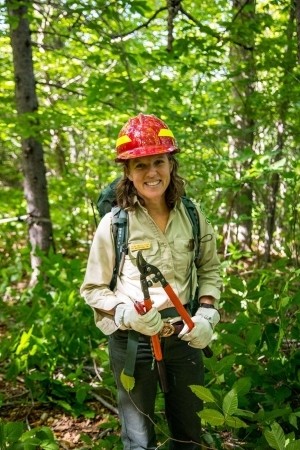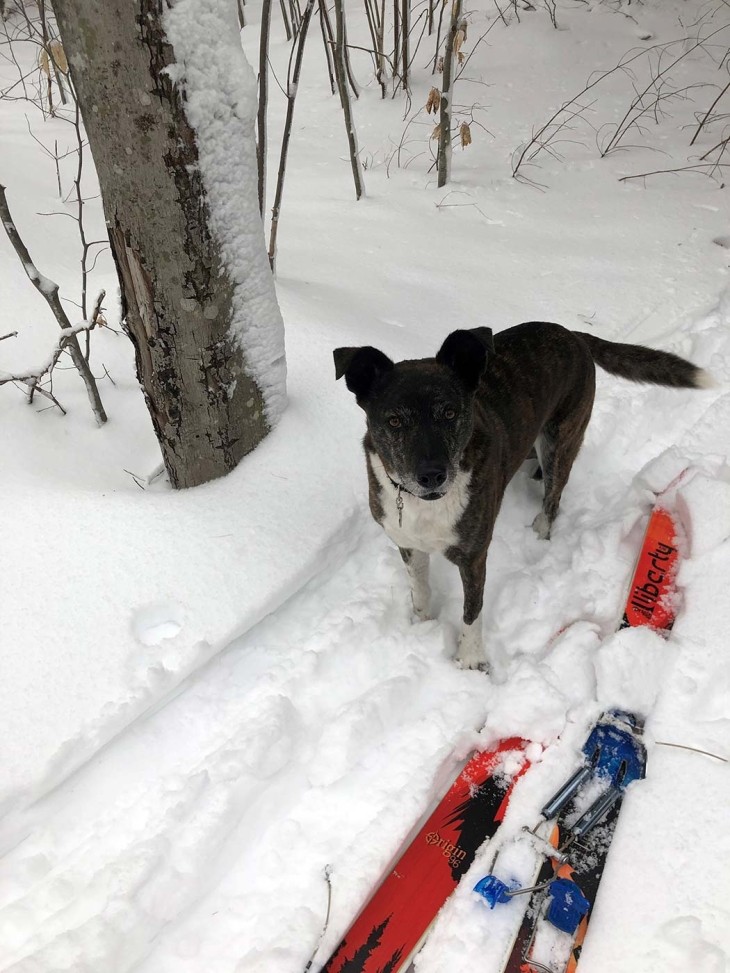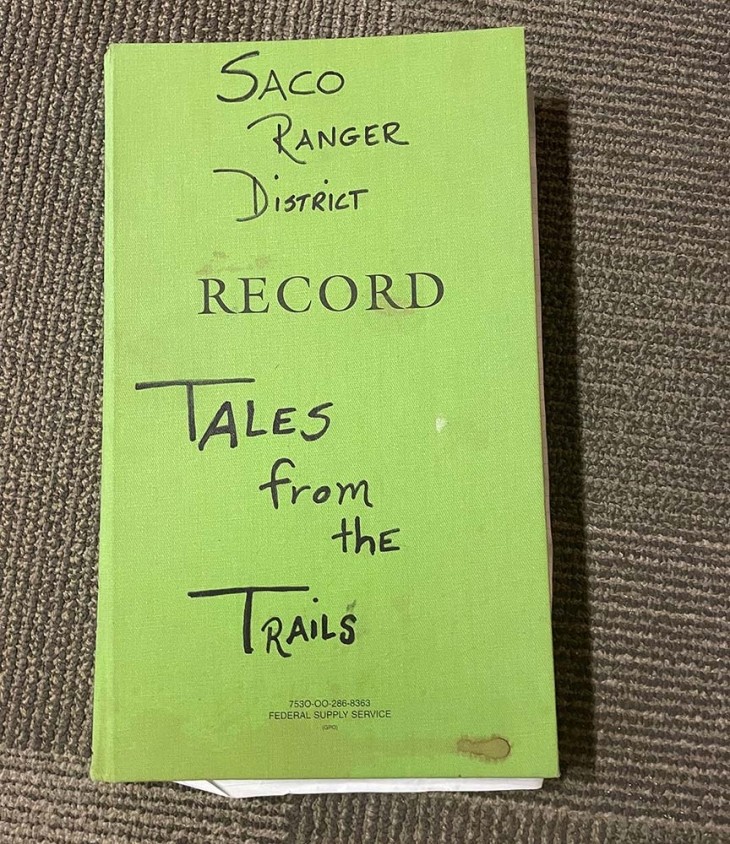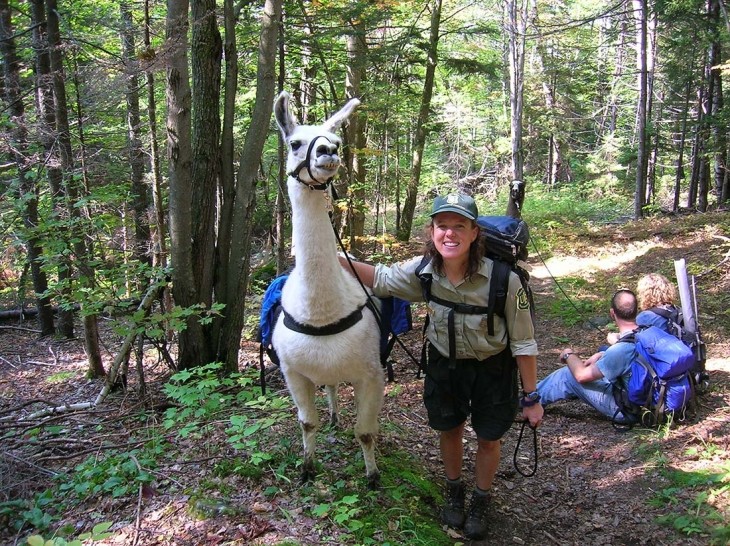
Given her early introduction to nature-based education, it’s hardly a surprise that Dylan Kinsella Alden has pursued a career that puts her outside and includes educating others about responsible forest use and recreation. As the Dispersed Recreation Manager for the Saco Ranger District in the White Mountain National Forest, Dylan oversees the trails, backcountry, and wilderness programs. And even when she’s not on the job, she’s often outside, exploring the woods and waters of the White Mountains.
As a kid, my favorite things to do were play with my dog, ride horses, find natural cave-like features in vegetation and hang out, go sledding, and just explore. My first school was the Upland Hills Farm School, a kindergarten through 8th grade school in Oxford, Michigan. I walked through fields to school, played on a fallen down tree – a.k.a. the school jungle gym – and had free time hanging out under the solar collectors which helped to power my school. My classes were things like bee keeping, flower pot bread baking, theater play shop, and KTK class (Kids teach Kids) – just your general outdoor, earthy-based school where my connection to the natural world was enthusiastically fostered.
All of my life I have been drawn to jobs which have kept me outside and connected to the natural world, ever since a rough patch of three weeks working at Taco Bell in high school. I went to a public high school in Indiana, which was a bit of a shock – going from a K through 8 school of 50 students to a public high school of 2,000. I ended up staying in Indiana to go to Earlham College, a small liberal arts college, where I earned a bachelor’s degree in biology.
The summer before my senior year of college and the summer after graduation, I had a seasonal job studying ground squirrels in Gothic, Colorado, at the Rocky Mountain Biological Laboratory. Over the years I have also worked at an Indiana state park horse stable, as a horse wrangler in Colorado, at multiple apple orchards as a farm hand, and as an outdoor education counselor for an environmental overnight camp. After college, I lived in Boulder, Colorado, for four years. I met a boy there and followed him back east, which turned out to be a good move – we’re married and living happily in New Hampshire.
When I found myself on the East Coast, I stopped by a U.S. Forest Service ranger station and asked about seasonal work and I landed a seasonal backcountry patrol job in Gorham, New Hampshire. That was in 1998. After 6 years of seasonal positions, I was hired for a permanent position, which eventually turned into a year-round position of supervisor of the backcountry and wilderness program.
There are three ranger districts in the forest, and I work out of Conway in the Saco Ranger District. The White Mountain National Forest is about 800,000 acres, and each district is roughly a third of that total. I now supervise the backcountry wilderness supervisor and the trails manager for the Saco Ranger District. There are two to four seasonal backcountry ranger positions on each of the three districts. Backcountry patrols happen on every trail and every area on each of the districts – peaks, backcountry facilities, and other popular or sensitive destinations.
The focus is on education – including Leave No Trace, Hike Safe, forest regulations, backwoods and wilderness ethics – as well as maintenance of backcountry infrastructure, including shelters, composting toilets, fire towers, cabins, and hiking signs. We also enforce Forest Service regulations with warnings and violation notices, work to naturalize overused sites, and are the eyes for the trail crew to let them know of problem areas as well as helping by doing some trail clearing ourselves. We have a dedicated trail crew who is responsible for maintaining the hiking and biking trail corridors. They also keep an eye out for things the backcountry crew may need to know. We also have a pod of very dedicated volunteers who help in the backcountry for each district, both on trails and backcountry patrols.
One of these volunteer-led efforts is the trailhead stewards program, which has been amazing. That was started around 2016 by my colleague who works on the Pemigewasset District over in Campton in response to the increase in search and rescue missions, especially in alpine environments, where people can get over their heads very quickly. It started with a few volunteers and a handful of trailheads. I think we’re up to eight trailheads, and it’s run by volunteers now. They have information about Hike Safe and Leave No Trace. They’re great at tracking how many people they’ve contacted and how many people turn around at their information table and either choose a different hike or go back to their car to get more gear so they’re prepared. Fish & Game has agreed that they’ve seen a decrease in search and rescue call outs where there are stewards at the trailheads.
I have a love of all things outdoors and a bigger passion to connect with people who also have that love and encourage people who have yet to realize that passion. I love sharing the gorgeous place I call my home and office with people who have never been here or don’t know the area well and are asking advice. Of course, we run into all kinds of situations out there. We actually have a journal called “Tales from the Trails,” where we jot down the stories too good to be forgotten – the ones in the category of “You can’t make this stuff up!” This one left me speechless: We went out to check on one of our 3-sided shelters in the spring and found that someone had packed in a small wood stove to use for warmth. They cut a hole in the new metal roof – in a three-sided shelter! – so they could place the chimney through it.
Another “Tale from the Trail” is from a few years ago, when we were on a crusade to educate people about proper human waste disposal in the backcountry. We even handed out orange poop trowels to get the conversation started. I met some scouts and their leaders on a 3-day backpack, and when I asked how they are disposing of their human waste, the kids answered, in unison, “We’re holding it in!” They all went home with their own orange shovel and some tips!
So many things that are frustrating aspects of our job can be chalked up to naivety or unawareness, and that encourages us all to be better educators. It seems like it should be common sense to clean up after yourselves, but we find everything from pooping on the surface and cutting live trees down to burn to leaving a full campsite of tents, chairs, and coolers. It can be super frustrating to discover – and even more so to pack it out miles.
Part of our job is also to work on the human waste composting at the backcountry outhouses. I think I dry-heaved my way through my first season, but it doesn’t take long to acclimate. Now it’s a bunch of joke telling, laughing, and wondering how to swat the black flies away from your face without using your hands. There is actually a full-on backcountry sanitation manual. There’s so much science to it. It’s super cool. And the end result is bark chips that we can re-use and other material that we can safely distribute on the forest floor.
There are so many other good challenges like the 40- to 60-mile weeks carrying heavy loads into the forest to do facility maintenance in really amazing areas. Once we even tried using llamas to help get wood stoves up to our backcountry rental cabins at Black Mountain and Doublehead in Jackson. I had a connection to a llama farmer who wanted to start doing llama packing, so this was their first attempt. Honestly, I think I carried more weight than the llama did. It was a one-time deal. But llamas are pretty strong if they’re acclimated to the mountains, and they’re pretty cute, too.
When I’m not working, I love to run, paddle, ski, hike, saunter, swim, bike, Nordic skate. Most of my favorite places are top secret, mostly off trail, sometimes with water and sometimes at the tippy top of the world. I’ve spent so much of my professional life on trails and making contact with folks on those trails, I’ve found my recent love is to just lose myself off trail and enjoy not seeing anyone for a bit of time. My dog Breeze and my husband Mitch are my favorite exploring companions.
We’ve lived in Tamworth for about six years now. I love the accessibility of the outdoors. We can just roll into the hills behind our house, and we’re a 5-minute drive to some of the forest trailheads, which are wonderful. Even though they’re also my work, I recreate there happily. We’ve just absolutely fallen in love with the community here.




